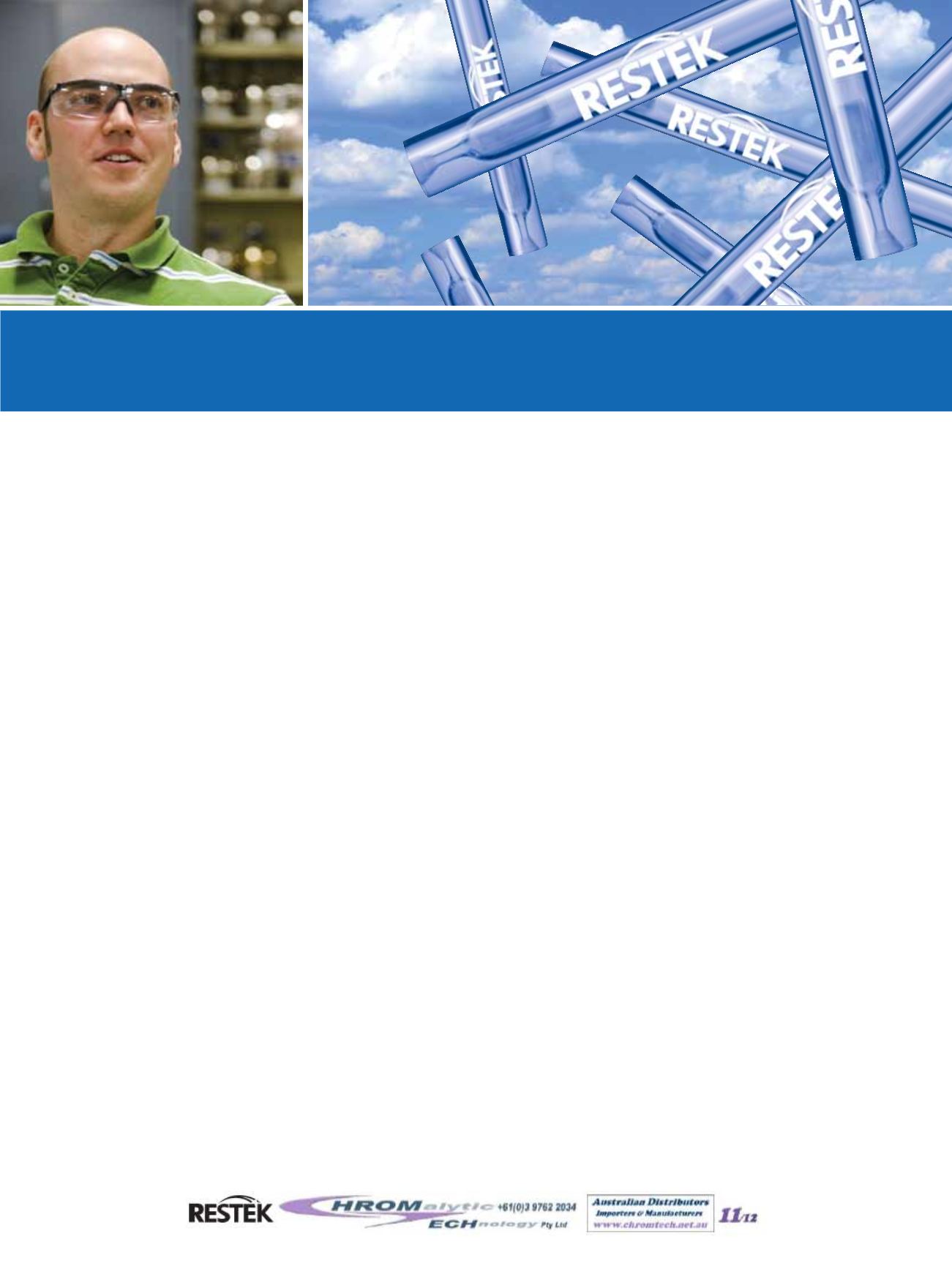
 www.restek.com
www.restek.com
|
800-356-1688
| Feedback? E-mail
advantage@restek.com20
By Scott Grossman
• An obstruction like wool is a must for efficient vaporization under
split conditions.
• Wool is also necessary under splitless conditions to minimize sample loss
and improve transfer onto column.
• With exceptionally inert Sky™ inlet liners, you can use wool with confidence.
When running a split injection with an autosampler, few would challenge that you need a liner with an obstacle like wool to achieve accurate,
precise results. After all, when you combine a fast injection with a high split flow rate, your sample simply needs more time to vaporize or
else it may be lost out the split vent. Wool stops the sample and gives it the time it needs to efficiently and completely vaporize, presenting a
homogenous mixture to the column and split vent. Unlike in split injections, conventional wisdom has long held that you do not need wool
under splitless conditions. However, a highly recommended paper by Bieri et al. argues that wool is just as important in splitless work. [1]
Should Splitless Mean Wool-Free?
Why do so many chromatographers believe that wool is not necessary to get accurate and representative sample transfer in a splitless run?
The only flow out of the inlet (other than the septum purge) is through the column, so the thinking is that, since the flow will be so much
slower than it is under split conditions, the sample will have ample time to vaporize and transfer onto the column without assistance. But,
could autoinjecting the sample using a fast plunger speed pose a problem? And can’t the sample still become trapped or be lost? The visu-
alization and chromatographic experiments Bieri et al. outlined were very effective in supporting their claim that wool is a must for split
and
splitless runs alike. So, I decided to expand upon their work using common styles of splitless liners.
Putting Wool Through the Wringer
Since the integral question is whether you lose sample when performing splitless injections without wool, I opted to benchmark with cold
on-column injections to force 100% of the sample onto the column. My sample was a 17-component mixture of straight-chain hydrocarbons
spanning a molecular weight range from C8 to C40. In addition to cold on-column capability, my GC also had a split/splitless inlet, so I col-
lected all response data using the same FID.
Figure 1 shows the data from a series of splitless analyses using the same sample but different liners. Results clearly illustrate that, for a wide
molecular weight range, the use of wool—or to a lesser degree another obstacle like a cyclo double gooseneck—is necessary for accurate
sample transfer and a reduction of molecular weight discrimination. You can also see that the only time the entire mass of analytes was trans-
ferred to the column under splitless conditions was when we employed a single gooseneck with wool. The liners with no obstruction had
much less desirable results.
Use Wool With Confidence
Of course, there is a reason why one may prefer not to use wool: It is a common source of activity that can break down and trap sensitive
analytes. In that case, how do you avoid counteracting wool’s advantage in improving vaporization? The wool in a Sky™ inlet liner is made of
fused quartz and is deactivated after packing, reducing the loss of sensitive analytes (Figure 2). By using Sky™ liners with exceptionally inert
wool, you can help ensure efficient vaporization and improved transfer onto your column for more accurate results and lower detection limits.
With Restek Sky™ inlet liners, you can use wool with confidence—and should under split
and
splitless conditions.
Rethinking the Use of Wool With Splitless GC
Website :
www.chromtech.net.auE-Mail :
info@chromtech.net.auTelNo : 03 9762 2034 . . . in AUSTRALIA











